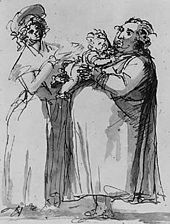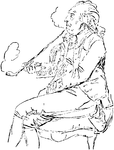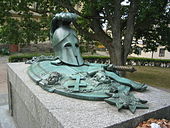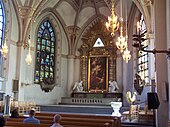Johan Tobias Sergel
Johan Tobias Sergel (* August 28 jul. / 8. September 1740 greg. In Stockholm ; † 26. February 1814 ) was a Swedish sculptor and draftsman . He is considered the most important classicist artist and one of Sweden's greatest sculptors .
Life
Sergel (until 1808 Sergell) was the son of gold, silver and pearl embroiderers Kristofer Sergell from Jena and his wife Elisabeth (née Zwirner), who immigrated to Sweden from Germany in the 1730s. He began an apprenticeship as a stonemason in palace construction in Stockholm and from the age of 15 received lessons in drawing and modeling from Jean Eric Rehn and from 1756 from Pierre Hubert L'Archevêque. In 1758 he traveled to Paris with L'Archevêque , where he stayed for seven months and won a medal from the art academy.
After his return he was called in by the palace building deputation to work on the sculptural decoration of the royal palace . In 1761 he was awarded the great gold medal of the Stockholm Art Academy. In 1767 he received a scholarship from the Castle Building Fund and the Art Academy, with which he realized his long-cherished dream of a trip to Italy. In August he arrived in Rome , where the realization of his artistic deficits initially plunged him into a deep depression. Then he decided to do a thorough study of anatomy, ancient sculpture and Renaissance painting. Jakob Philipp Hackert and Johann Heinrich Füssli were among his artist friends in Rome .
1778 Sergel was by the Swedish King Gustav III. recalled and returned to Stockholm via Paris and London, where he arrived in June 1779 after having become a member of the Royal Academy of Painting and Sculpture in Paris. Gustav III appointed him as the successor to L'Archevêques royal sculptor and in 1780 professor at the art academy. In Stockholm he was at the center of a fun-loving circle of friends, including the poet Carl Michael Bellman . In 1783 he traveled as the companion of King Gustav III. again for nine months to Italy.
With the exception of two short stays in Copenhagen in 1794 and 1796, Sergel spent the rest of his life in Stockholm, where he was in the highest favor with the king and the public. In 1803 he was appointed court manager and ennobled in 1808. This led to his name change from Sergell to Sergel as a result of a spelling mistake in the letter of nobility. Since 1803 Sergel was also an external member of the Académie des Beaux-Arts . Sergel remained unmarried, but had a son Gustav with his landlady Anna-Rella Hellström, whom he legitimized and who continued his name. After Sergel's death, his artistic estate was purchased by the Swedish state in 1815.
plant
Sergel is considered to be the founder of Swedish sculpture. Before him, large sculptures in Sweden were only created or imported by foreign artists.
His years in Rome were of decisive importance for Sergel's artistic development. They shaped him so much that he later wrote that "my studies really began" on the day he arrived in Rome. Before that, he had made a statue of King Gustav I and an equestrian statue of King Gustav Adolf II in the typical French rococo taste based on designs by L'Archevêque . In Rome, where he intensively copied ancient sculptures, he turned into a classicist who only recognized “antiquity and nature” as a teacher, and became, alongside Thorvaldsen, one of the most important representatives of classicism in the Nordic countries.
Compared to other classical artists, his works stand out due to their lively movement. Important works of the Roman period are the "Reclining (or: Drunk) Faun" (1770–1774), which established his fame as a sculptor, and the group "Amor and Psyche", which was originally intended for Madame Dubarry . After his return to Stockholm he created the Descartes monument (1781) and the resurrection relief (1785) in the Adolf Friedrich Church . The bronze statue of Gustav III is considered to be his main work . which was bought by the City of Stockholm in 1796 and placed in front of the Royal Palace.
In a remarkable contrast to Sergel's sculptural work are his drawings, which are often sketchy, sometimes caricatured and of an expressive realism, stylistically reminiscent of Füssli . In contrast to his gruesomely romantic subjects, in addition to mythological themes, they prefer scenes from everyday life and are therefore also significant as a cultural-historical source.
Sergels Torg , a square in the center of Stockholm, was named after Sergel . There is now a statue of Sergel on the site of his former studio.
gallery
Carl Michael Bellman . Pen drawing by Johan Tobias Sergel, ca.1790
Baron Clemens August von Haxthausen in Stockholm. Drawing by Johan Tobias Sergel, 1782
Augustin Ehrensvärd's grave on Suomenlinna , Johan Tobias Sergel, ca.1772
Karlstad Cathedral , the old altar with angels by Johan Tobias Sergel
Klarakirche in Stockholm - the altar is framed by two kneeling angels, which were made in 1904 from plaster originals by Johan Tobias Sergel
Gustav III - Statue of Johan Tobias Sergel in Stockholm, painting by Fritz von Dardel , 1860
literature
- Johan Tobias Sergel . In: Svenska familj-journalen . tape 6 , year 1867, booklet 1. CE Gernandts förlag, Halmstad 1867, p. 23–24 ( runeberg.org - With a picture of Sergel's lying Faun).
- Sergel, Johan Tobias . In: Herman Hofberg, Frithiof Heurlin, Viktor Millqvist, Olof Rubenson (eds.): Svenskt biografiskt handlexikon . 2nd Edition. tape 2 : L – Z, including supplement . Albert Bonniers Verlag, Stockholm 1906, p. 452-453 (Swedish, runeberg.org ).
- Georg Nordensvan : Sergel (Sergell), Johan Tobias . In: Theodor Westrin, Ruben Gustafsson Berg, Eugen Fahlstedt (eds.): Nordisk familjebok konversationslexikon och realencyklopedi . 2nd Edition. tape 25 : Sekt – Slöjskifling . Nordisk familjeboks förlag, Stockholm 1917, Sp. 167–173 (Swedish, runeberg.org - with some illustrations).
- Carl Grimberg : Johan Tobias Sergel . In: Svenska folkets underbara öden . tape 7 : Gustaf III: also Gustav IV Adolfs tid 1772–1809 . PA Norstedt & Söners Förlag, Stockholm 1921, p. 237–250 (Swedish, runeberg.org - with several illustrations).
- Oscar Antonsson : Sergel, Johan Tobias . In: Hans Vollmer (Hrsg.): General lexicon of fine artists from antiquity to the present . Founded by Ulrich Thieme and Felix Becker . tape 30 : Scheffel – Siemerding . EA Seemann, Leipzig 1936, p. 509 .
- Magnus Jacob Crusenstolpe : 1814 Johan Tobias Sergel död. In: Erik Lindorm (ed.): Carl XIV Johan - Carl XV och deras tid: 1810–1872: en bokfilm . Wahlström & Widstrand, Stockholm 1942, p. 44 (Swedish, runeberg.org - obituary with pictures).
- Oscar Antonsson: Sergels ungdom och Romtid. Norstedt, Stockholm 1942.
- Werner Hofmann (Ed.): Johan Tobias Sergel. Catalog for the exhibition in the Hamburger Kunsthalle from May 22 to September 21, 1975. (Texts by Per Bjurström, Werner Hofmann, Hanna Hohl, Sven Ulric Palme). Prestel, Munich 1975, ISBN 3-7913-0355-4 .
Web links
- Sergel's works in the Louvre (Paris)
- Sergels Faun in the Sinebrychoff Art Museum, Helsinki
- Sergels Amor and Psyche in the National Museum Stockholm
Individual evidence
- ^ Georg Nordensvan : Sergel (Sergell), Johan Tobias . In: Theodor Westrin, Ruben Gustafsson Berg, Eugen Fahlstedt (eds.): Nordisk familjebok konversationslexikon och realencyklopedi . 2nd Edition. tape 25 : Sekt – Slöjskifling . Nordisk familjeboks förlag, Stockholm 1917, Sp. 167 (Swedish, runeberg.org - both practiced this craft).
- ^ Sculpture (National Museum Stockholm). (No longer available online.) Archived from the original on December 10, 2012 ; Retrieved May 19, 2019 (Swedish).
| personal data | |
|---|---|
| SURNAME | Sergel, Johan Tobias |
| ALTERNATIVE NAMES | Sergell, Johan Tobias |
| BRIEF DESCRIPTION | Swedish sculptor and draftsman |
| DATE OF BIRTH | September 8, 1740 |
| PLACE OF BIRTH | Stockholm , Sweden |
| DATE OF DEATH | February 26, 1814 |
| Place of death | Stockholm , Sweden |








